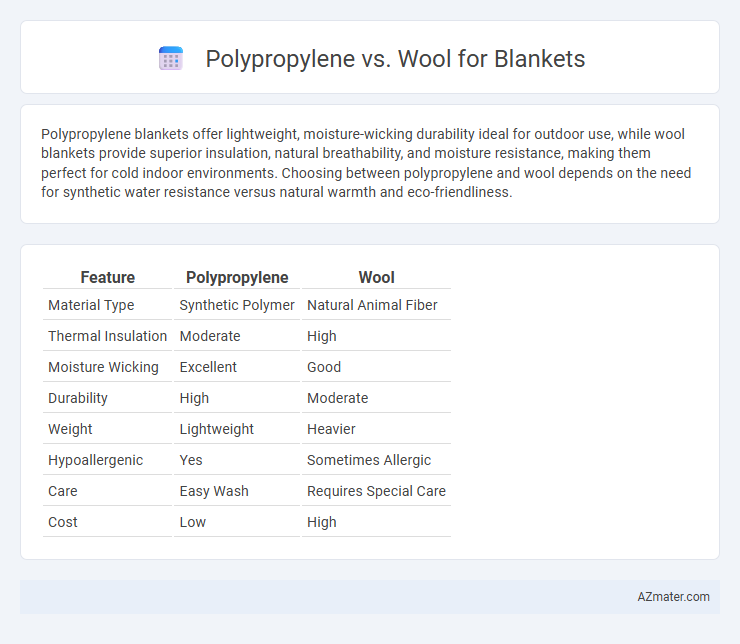Polypropylene blankets offer lightweight, moisture-wicking durability ideal for outdoor use, while wool blankets provide superior insulation, natural breathability, and moisture resistance, making them perfect for cold indoor environments. Choosing between polypropylene and wool depends on the need for synthetic water resistance versus natural warmth and eco-friendliness.
Table of Comparison
| Feature | Polypropylene | Wool |
|---|---|---|
| Material Type | Synthetic Polymer | Natural Animal Fiber |
| Thermal Insulation | Moderate | High |
| Moisture Wicking | Excellent | Good |
| Durability | High | Moderate |
| Weight | Lightweight | Heavier |
| Hypoallergenic | Yes | Sometimes Allergic |
| Care | Easy Wash | Requires Special Care |
| Cost | Low | High |
Introduction to Blanket Materials
Polypropylene and wool are two popular materials used in blanket manufacturing, each offering distinct thermal properties and durability. Polypropylene is a synthetic fiber known for its lightweight, moisture-wicking, and quick-drying capabilities, making it ideal for outdoor and active use. Wool, a natural fiber sourced from sheep, provides superior insulation and breathability, excelling in warmth retention and moisture regulation.
What is Polypropylene?
Polypropylene is a synthetic polymer derived from propylene monomers, widely used for making durable, lightweight, and moisture-resistant fabrics. In blankets, polypropylene offers excellent insulation and quick-drying properties, making it ideal for outdoor and hypoallergenic uses. Unlike wool, polypropylene is less breathable but more resistant to mildew and stains, providing a practical alternative for easy-care bedding.
What is Wool?
Wool is a natural fiber obtained from the fleece of sheep, renowned for its exceptional insulation and moisture-wicking properties. Its breathable structure regulates temperature effectively, making wool blankets highly comfortable in both cold and warm conditions. Compared to polypropylene, wool offers superior durability, sustainability, and biodegradability, enhancing its appeal as an eco-friendly and long-lasting blanket material.
Warmth and Insulation Comparison
Polypropylene blankets offer excellent moisture-wicking properties and retain heat even when damp, making them highly effective for insulation in cold conditions. Wool blankets provide superior natural thermal regulation by trapping heat in their crimped fibers while allowing breathability, ensuring consistent warmth without overheating. Comparing warmth and insulation, wool excels in temperature regulation and durability, whereas polypropylene is prized for lightweight, water-resistant heat retention.
Comfort and Texture Differences
Polypropylene blankets offer a smooth, lightweight texture that is moisture-resistant and quick-drying, providing a soft yet less breathable feel compared to natural fibers. Wool blankets deliver superior warmth with a dense, slightly coarse texture that naturally regulates temperature and wicks moisture away from the skin, enhancing overall comfort. The choice between polypropylene and wool depends on preferences for softness, insulation, and breathability, with wool excelling in warmth and moisture management while polypropylene is ideal for easy maintenance and lightweight comfort.
Durability and Longevity
Polypropylene blankets are highly durable, resistant to wear, moisture, and mildew, making them ideal for long-term use in varied climates. Wool blankets offer exceptional longevity due to their natural fiber strength and self-cleaning properties, maintaining insulation and resilience over decades. Comparing both, polypropylene excels in moisture resistance while wool surpasses in breathability and natural durability, with each material's lifespan depending on usage conditions.
Allergy Potential and Hypoallergenic Properties
Polypropylene blankets are highly favored for their hypoallergenic properties, as the synthetic fibers resist dust mites, mold, and bacteria, making them ideal for allergy sufferers. Wool blankets, while natural and breathable, may trigger allergic reactions in sensitive individuals due to lanolin, a natural oil found in wool fibers. Choosing polypropylene can reduce allergy potential significantly, offering a safer option for people prone to respiratory issues or skin sensitivities.
Maintenance and Care Requirements
Polypropylene blankets require minimal maintenance, as they are machine washable, quick-drying, and resistant to stains and mildew, making them ideal for easy care routines. Wool blankets demand more careful handling, typically needing gentle washing or dry cleaning to avoid shrinking and fabric damage, which increases their maintenance effort. Wool's natural lanolin content provides some resistance to dirt and odors, but proper drying and storage are essential to prevent moth infestation and preserve the fibers.
Environmental Impact and Sustainability
Polypropylene blankets have a lower biodegradability rate, contributing to long-term environmental pollution, though they require less water and energy during production compared to wool. Wool is a renewable resource with natural biodegradability and excellent insulation properties, but its production involves significant land use and methane emissions from sheep farming. Choosing between polypropylene and wool blankets hinges on balancing synthetic material durability with the renewable, biodegradable benefits of natural fibers.
Which Blanket Material is Best for You?
Polypropylene blankets offer excellent moisture-wicking properties and durability, making them ideal for people with allergies or those seeking easy-care options. Wool blankets provide superior warmth, natural insulation, and breathability, perfect for cold climates and individuals who value eco-friendly, sustainable materials. Choosing between polypropylene and wool depends on your priorities for warmth, maintenance, and skin sensitivity.

Infographic: Polypropylene vs Wool for Blanket
 azmater.com
azmater.com